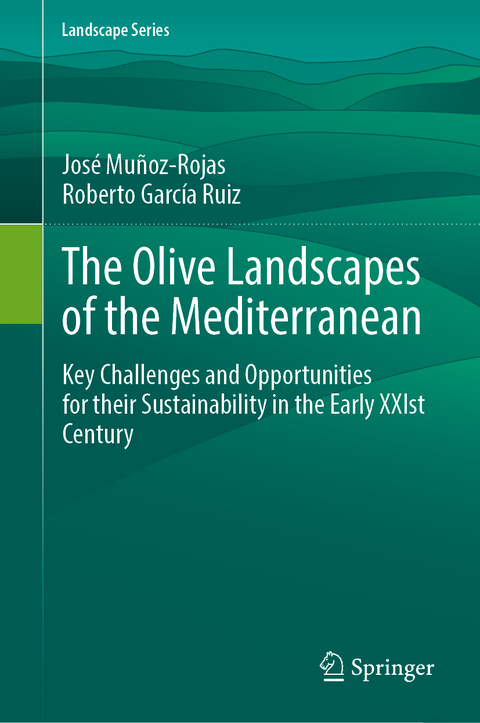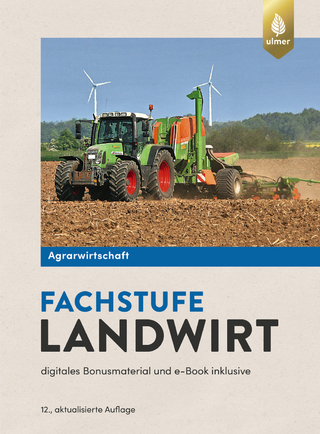
The Olive Landscapes of the Mediterranean
Springer International Publishing (Verlag)
978-3-031-57955-4 (ISBN)
- Noch nicht erschienen - erscheint am 04.01.2025
- Versandkostenfrei
- Auch auf Rechnung
- Artikel merken
This book provides a state-of-the-art review of the current models and typologies of olive landscapes and related farming systems in the Mediterranean. It also explores potential prospects for monitoring and enhancing their sustainability standards. Olive groves are an essential component of the historical landscape that largely drive the cultural, ecological and socio-economic character of the region. Agronomic intensification and mechanization, market globalization and delocalization, and financialization are affecting these ancient farming systems in certain olive landscapes, whereas others are threatened by abandonment and financial loss. This complex set of processes is resulting in a heterogeneous mosaic of olive landscapes when examined across nested spatial-temporal scales and institutional levels. In alignment with such complexity, multiple challenges are arising linked to sustainability standards and targets. Sustainability has actually been the subject of much public discussion and yet of not nearly enough scientific evidence-gathering that is both robust and comparable across geographic contexts and scales. This is where this book is expected to provide a meaningful contribution.
Ultimately, the main objective of this book is to establish a base-line sustainability picture of the complex mosaic of olive landscapes across the Mediterranean region. The book is structured along a series of national /regional and thematic reviews and syntheses, which lead to joined-up reflections on current and future challenges, opportunities and trajectories for enhancing the sustainability of olive landscapes across the Mediterranean. The book will be of interest to academics and researchers, policy-makers, the farming community, and market agents alike. We expect that they will find in this book an overall picture of the sector´s current situation and plausible pathways for achieving enhanced sustainability standards, whilst also permitting the reader to gain depth on the contingent characteristics of the different drivers, components and typologies of these dynamic and valuable landscapes.
José Muñoz-Rojas is Assistant Professor and Researcher at the Universidade de Évora (Portugal). He is a rural geographer and landscape ecologist, with a focus in unraveling the complex and non-linear trajectories of change in Mediterranean rural landscapes, and devising pathways to enhance their sustainability and resilience. He is a member of the editorial board on Landscape Ecology (Springer-Nature) and of the scientific board of the European chapter of the International Association of Landscape Ecology. He is also a small olive farmer in Alentejo (Portugal), where he lives with his family...and other animals.
Roberto García-Ruiz is full Professor in Ecology, coordinator of the Ecology section of the University Institute of research olive groves and olive oil and Researcher at the University of Jaén (Spain). As a dedicated researcher, his work centers on evaluating the effectiveness of sustainable management practices in enhancing ecosystem services, with a particular emphasis on climate change mitigation, soil health, and the dynamics of organic carbon and nutrients.
1. Olive Groves in the Mediterranean in 2023 - A Heterogeneous and Dynamic Mosaic of Rural Landscapes and Ecosystems.- Section II. Olive Landscapes Across the Mediterranean: Regional Herrogeneity and Case Studies: Olive Groves and Landscapes in Spain.- 2. Notes for a Socio-ecological History of the Spanish Olive Grove.- 3. Pedoclimatic and Landscape Conditions of the Spanish Olive Groves.- 4. Cultivars and Olive Growing Systems in Spain.- 5. Soil management practices and fertilization in Spain.- 6. Pruning and Harvesting of Olive Groves in Spain.- 7. Pests and Infectious Diseases of the Olive Trees in Spain, and Main Control Strategies.- 8. Challenges for Sustainable Water Resource Management in the Spanish Olive Orchards.- 9. Management Practices Boosting Ecosystem and Landscape Functions and Services in Spain.- 10. Market Challenges in Spanish Olive Groves.- Section III. Olive Landscapes Across the Mediterranean: Regional Herrogeneity and Case Studies: Olive Groves and Landscapes in Italy.- 11. A Historical and Social Insight of Olive Groves and Landscapes in Italy.- 12. Pedoclimatic and Landscape Conditions of Italian Olive Groves.- 13. Varieties and Olive Grove Production Systems in Italy.- 16. Challenges for Sustainable Water Resource Management in Italy.- 17. Management Practices Boosting Ecosystem Services and Life Cycle Assessment of Italian Olive Groves.- 18. Market Challenges in Italian Olive Groves.- Section IV. Olive Landscapes Across the Mediterranean: Regional Herrogeneity and Case Studies: Olive Groves and Landscapes in Greece.- 19. A Historical and Social Insight of Olive Groves and Landscapes in Greece.- 20. Pedoclimatic and Landscape Conditions of Greek Olive Groves.- 21. Varieties and Olive Grove Production Systems in Greece.- 22. Soil Management Practices, Fertilization, Pruning and Harvesting of Greek Olive Groves.- 23. Pest and Diseases and Main Control Strategies of Greek Olive Groves.- 24. Challenges for Sustainable Water Resource Management in Greek Olive Groves: Irrigation and Salinity.- 25. Management Practices Boosting Ecosystem and Landscape Functions and Services in Greek Olive Groves.- 26. Market Challenges in Greek Olive Groves.- Section V. Olive Landscapes Across the Mediterranean: Regional Herrogeneity and Case Studies: Olive Groves and Landscapes in Portugal.- 27. A historical and Social Insight of Olive Groves and Landscapes in Alentejo, Portugal.- 28. Pedoclimatic and Landscape Conditions of Portuguese Olive Groves.- 29. Varieties and Olive Grove Production Systems in Portugal.- 30. Soil Management Practices, Fertilization, Pruning and Harvesting of Portuguese Olive Groves.- 31. The Phytosanitary Protection of the Portuguese Olive Grove. Current and Future Perspectives.- 32. Agricultural Intensification in The Alentejo Region: Effects on Water Quality and Water Suitability for Irrigation.- 33. An Ecosystem Service-based Approach to Adapt Olive Production to Climate Change.- 34. Market Challenges in Portuguese Olive Groves.- Section VI. Olive Landscapes Across the Mediterranean: Regional Herrogeneity and Case Studies: Olive Groves and Landscapes in Tunisia.- 35. A historical and Social Insight of Olive Groves and Landscapes in Tunisia - O. Boussadia.- 36. Pedoclimatic and Landscape Conditions of Tunisian Olive Groves.- 37. Varieties and Olive Grove Production Systems in Tunisia.- 38. Soil Management Practices, Fertilization, Pruning, and Harvesting of Olive Groves in Tunisia.- 39. Challenges for Sustainable Water Resources Management: Irrigation and Salinity in Tunisian Olive Groves.- Section VII. Olive Landscapes Across the Mediterranean: Regional Herrogeneity and Case Studies: Olive Groves and Landscapes in Morocco.- 40. A Historical and social Insight of Olive Groves and Landscapes in Morocco.- 41. Pedoclimate and Landscape Conditions of the Moroccan Olive Groves.- 42. Varieties and Olive Grove Production Systems.- 43. Soil Management Practices, Pruning and Harvest of Olive Groves in Morocco.- 44. Pest and Diseases and Main Control Strategies in Moroccan Olive Groves.- 45. Challenges for Sustainable Water Resource Management Irrigation, Salinity and Contamination in Moroccan Olive Groves.- 46. Management Practices Boosting Ecosystem Services in Moroccan Olive Groves.- 47. Market Challenges for Moroccan Olive Groves.- Section VIII. Olive Landscapes Across the Mediterranean: Regional Herrogeneity and Case Studies: Local Innovative Approaches to the Management of Olive Groves and Landscapes Across the Mediterranean.- 48. Denomination of Origin Estepa.- 49. Agricultural Cooperative of Kalamata.- 50. NILEAS Producers Group Company A.C.- 51. Italian Association for Organic Agriculture.- 52. UNAPROL.- 53. Omniya and Houda Women's Cooperative in Bellouta.- 54. The Centre for the Study and Promotion of Olive Oil in Alentejo.- 55. Implementing sustainability strategies and standards in a farming enterprise: Esporão lda (Alentejo, Portugal).- Section IX. Olive Oil: Diversity, Heterogeneity and Quality Challenges.- 56. Origin and Traceability of Olives and Olive Oils in the Mediterranean Area: Genomic, Metabolomic and Control Insights.- 57. Olive Oil Extraction and Table Olive Industries.- 58. Current State of Technological Applications and Novel Approaches to Value-Adding Methods for Byproducts from Oil Mills.- Section X. Olive Landscapes in The Mediterranean Transitioning Towards Enhanced Sustainability: Key Challenges and Opportunities.- 59. Weakness, Threats, Strengths and Opportunities of the Olive Oil Sector and Olive Groves and Landscapes Across Mediterranean Countries and Regions.- 60. Olive Groves and Landscapes in the Mediterranean Looking into the Future - Challenges, Opportunities and Scenarios for More Sustainable Olive Landscape Delivering Multiple Functions and Services.
| Erscheinungsdatum | 26.06.2024 |
|---|---|
| Reihe/Serie | Landscape Series |
| Zusatzinfo | XIII, 676 p. 205 illus., 197 illus. in color. |
| Verlagsort | Cham |
| Sprache | englisch |
| Maße | 155 x 235 mm |
| Themenwelt | Weitere Fachgebiete ► Land- / Forstwirtschaft / Fischerei |
| Schlagworte | Farming Systems • Landscapes • land-use dynamics • Mediterranean • olive groves • sustainability |
| ISBN-10 | 3-031-57955-0 / 3031579550 |
| ISBN-13 | 978-3-031-57955-4 / 9783031579554 |
| Zustand | Neuware |
| Informationen gemäß Produktsicherheitsverordnung (GPSR) | |
| Haben Sie eine Frage zum Produkt? |
aus dem Bereich


